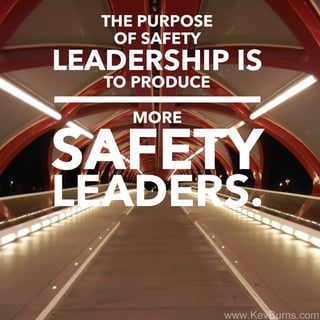4 Ways To Make Safety Positive
Stop discussing the negatives of not being safe. Instead, focus on the positives of buying-in to safety.
 Ask employees about how they perceive the safety program and they will most likely answer that it's dull, boring, repetitive, mind-numbing, disengaging, and it tries to scare you into compliance. That's because safety has been focused on following rules and avoiding injury or accidents. But like everything else in life, safety evolves.
Ask employees about how they perceive the safety program and they will most likely answer that it's dull, boring, repetitive, mind-numbing, disengaging, and it tries to scare you into compliance. That's because safety has been focused on following rules and avoiding injury or accidents. But like everything else in life, safety evolves.
Sure, there is still an expectation of meeting the minimum standards of safety. But, that's the least that the law will allow you to do. If the focus is to achieve the minimum standard, you are chasing compliance - the standard that you are not allowed to fall below. And when safety programs are focused only on achieving the minimum, that's where the organization will live.
As organizations are becoming more people-centric, they are integrating people-development programs. You cannot develop your people without including safety. The best-managed companies and employers-of-choice still value a profit but not at the expense of their good people. They are organizations that attract the best employees and hang onto them. As I say regularly, the best place to work is always the safest place to work.
The best employees are attracted to workplaces that focus on achieving positives, more than just avoiding negatives. The best workplaces have a plan to make the experience of working there a positive one.
Here are the four most important ways to focus your safety program on positives:
1Get their attention. You can’t talk to them if they’re not paying attention. So you, (manager, safety person or supervisor) have to get their attention. That means engaging one-on-one whenever possible. That means finding ways to include them in safety meetings not just making them sit there and get lectured to. Focused attention means engagement. Talking with people is far different than talking at them. When employees are included in the conversations, they take ownership. (Let's be clear, you can get their attention with gruesome photos and videos and sad stories, but that's momentary. And it's not positive.) You want to get their positive attention and focus. You want to keep it positive. A positive workplace is a great place to work. When people like where they work, they give more of themselves - far more than just the bare minimum.
2Identify what benefit safety delivers. Insurance salespeople know that life insurance is dry and boring so they don’t focus only on the negatives. They know that it’s tougher for customers to make a positive step to purchase insurance if all the focus is on negatives. You don’t scare someone into buying and then have them feel good about the decision they made. But we need insurance. And we need safety programs. So what benefit does safety deliver? Ask the question at a safety meeting and have an open discussion. Make the list of the benefits that safety delivers. Long life. Healthy future. Great teamwork. Fun working atmosphere. Positive morale. A sense of team achievement. Goals realized. These are positive benefits. Go on, make the list. (Keep the list focused on positives. Not getting hurt is not a positive. Change the wording so it reads as a realized , positive benefit.)
3Create a plan for making safety positive. Financial planners don’t offer financial advice on avoiding failure. They focus on plans for success. No one’s financial plan is to avoid living in a box under a bridge. Financial planners work on getting you to move forward toward a solid income in retirement with full ownership of your house. It is a certainty that if you work the positive financial plan, you assure yourself financial freedom. So then, what is the plan for safety? How is the outcome positive? What positive and proactive steps can you take each day that move you closer to achieving your goal? How can the whole team play a part in the plan? The key to success is to have a positive goal to achieve - not a negative failure to avoid.
4Focus on the future. While safety is traditionally focused on short-term outcomes, (in-the-moment processes and procedures), there is also a long-term focus on safety. The in-the-moment decisions must align with the future goals or outcomes you want for your life. Stop discussing the negatives of not being safe. Instead, focus on the long-term positives of buying-in to safety. Focus on what will happen to you. Here are a few suggestions. Watch your kids grow up. Christmas mornings. Worry-free retirement. Start a business. Twilight years at the lake house. Travel to exotic locations. These are some of the long-term, positive results of choosing safety in this moment. Once you’ve got your people thinking about their safe and secure future life, lay out the plan to safely get there.
 A positive safety program is one that moves forward with all of the members of the team playing a part in making it happen. It is focused on goals achievement - not failure-avoidance.
A positive safety program is one that moves forward with all of the members of the team playing a part in making it happen. It is focused on goals achievement - not failure-avoidance.
The real safety leaders work toward a goal of putting themselves out of work. To be so far ahead of the minimum standard that their own position could be considered redundant. Safety leaders are selfless. The interests of their people come before their own interests.
Twenty years ago, most of the safety positions we have today didn't exist. And they probably won't exist in another 20 years. Organizations evolve. They get better. In the future, safety will not be a thing applied to workplaces but will integrate with how we work.
If you, as a safety leader, truly want your people to be a positive part of your safety plan, begin to focus on making their experience with safety a positive one.
--
Kevin Burns collaborates with safety departments, safety committees, management and front-line supervisors to accelerate the safety program. Through consulting services to create a personalized plan to accelerate safety teamwork, or a safety meeting speaking presentation to rally your employees around safety, Kevin helps improve engagement and teamwork in safety.
Kevin Burns is a management consultant, speaker and author of “PeopleWork: The Human Touch in Workplace Safety.” He believes that the best place to work is always the safest place to work. www.KevBurns.com


